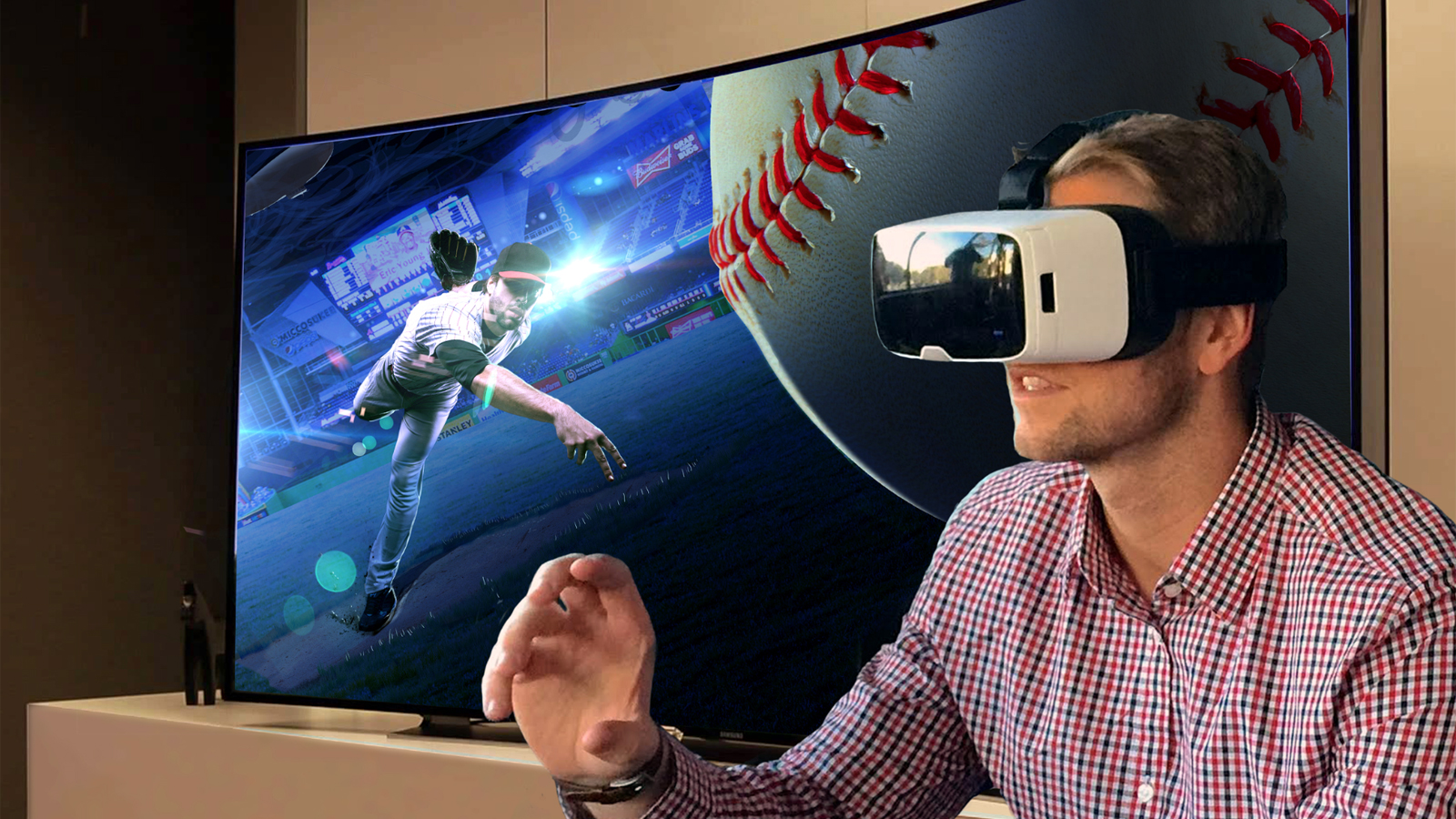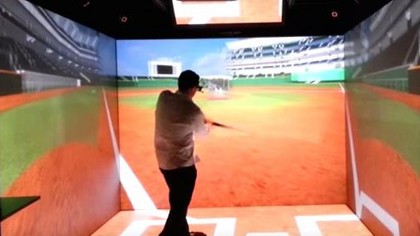Former New York Yankees slugger is training amateurs to hit a home run - in VR

Baseball gaming simulators like MLB: The Show try to recreate the excitement and challenge of professional baseball, but these hardly improve your actual athletic skills. To that end, one sports VR company is using the latest advancements in virtual reality technology to combine the fun and challenge of a game simulator with realistic graphics and effective batting practice. Plus, it's got former MLB slugger Jason Giambi going to bat for it.
I recently spoke with Giambi, a five-time All-Star and MVP, who has partnered with EON Sports to launch Project OPS, a virtual reality software for mobile devices that helps Little Leaguers and amateurs visualize the strike zone and recognize different types of pitches. The app purports to improve the user's "OPS": a hitter's statistical ability to hit for both contact and power.
Giambi made a name for himself as a home run-hitting juggernaut for the New York Yankees and Oakland Athletics, but, as described by the New York Times, his true batting skills came from his "uncanny ability to recognize" and predict pitches based on a pitcher's throwing motion. If a pitch deviated from his mental strike zone, he remained "as still as a statue."
So when EON Sports CEO Brendan Reilly, whom I also spoke, first showed Giambi test footage of a virtual reality pitcher, he immediately recognized its unique potential to train pros and kids alike in improving their strike zone awareness.
In EON's simulation, players stand in the batter's box and watch a pitcher throw toward them across home plate. Armed with a Bluetooth controller instead of a bat, the players must input whether or not the pitch was a strike, then progress toward determining the type of pitch (fastball, changeup, slider or curveball) as their practice scores improve.
Giambi isn't just endorsing the technology: he acts like a coach for users, too. He narrates interactive tutorials to users in-app, teaching them how to approach their at-bats. The startup package include more than 30 interactive challenges, along with Randomized and Customized Pitching Modes.
The Project OPS package - the mobile software, a custom-made VR headset for your smartphone, and a Bluetooth controller - can be pre-ordered for $159 (about £105, AU$224), but as the software runs on every virtual mobile platform, from Google Cardboard to Samsung Gear VR, you can purchase OPS minus the hardware for $59 (about £39, AU$83).
Sign up for breaking news, reviews, opinion, top tech deals, and more.

Replacing scouting reports with in 'game' practice
If I learned anything from speaking with Reilly and Giambi, it's that players and coaches are fed up with traditional scouting reports, and have been for a long time. Reilly recalled his time as a basketball coaching assistant at Kentucky University, where the players and coaches studied endless game film and wrote down strategies and player information for one upcoming opponent after another, to the point that everyone became inundated with too much information. "You can only digest so much with pen and paper," he says. Only after they faced opponents - seeing how they played with their own eyes and developing muscle memory - were they ready, ironically, to face them.
This problem only gets worse in baseball, according to Giambi. All game footage of at-bats and pitching motions comes from behind the pitcher, where you can memorize a pitcher's speed and pitch selection in the abstract, but can't actually "feel the pitch coming toward you" or "watch the ball leave his hand" and know where it'll likely end up.
Baseball players "need competition" to improve, Giambi argues. Other team sports like football and soccer let you train in scrimmages, but not in baseball.
"The only way to really get better is in the game," Giambi says. "Batting practice just never gives the same feel."
So unless a team wants to tire out its pitchers, typical hitting practice uses pitching machines, training your muscles but not your brain and instincts.
That's what makes virtual reality potentially so valuable for mentally training players: it provides the opportunity to immerse yourself in faux-game situations against your upcoming opponent. While the regular Project OPS consumer package has you facing a generic pitcher, Reilly says he's been selling an elite package to major league teams with the promise of facing customized aces.
In other words, before a game against the Dodgers' Clayton Kershaw, your players could potentially bat against a virtual 6-foot-4 lefty who throws 93 mph fastballs 54% of the time, and, proportionally for Kershaw's other pitches, to his favorite corners of the strike zone.
Project OPS' consumer edition may not have this level of variation, but it does place a premium on realism. Giambi was impressed when he first tried the product, but immediately saw flaws in its rendering of the pitcher, from how he released the ball to how the ball "skipped" out of his hand. Giambi helped iron out the kinks, and now he believes the realism gives amateurs the chance to practice their at-bats in "game" situations.

Swing away (eventually)
By designing Project OPS for mobile platforms, EON made the technology affordable and accessible to a huge potential user base of Little Leaguers around the world. Whereas most advanced baseball training centers can cost upwards of tens of thousands of dollars to build and wouldn't be accessible to most amateur players, Project OPS users can spend far less than that, and use it anywhere.
Unfortunately, designing for mobile devices has inherent limitations, most notably creating a realistic simulation that includes actually hitting virtual pitches. When I asked why they didn't include this feature, Reilly replied that a bat accessory with sensors that register the timing, speed and location of your swing in relation to Project OPS' pitch data would be an expensive piece of hardware. Combine that cost with an accurate in-app rendering of your swing and the flight of the ball, and suddenly the Project OPS app isn't widely accessible and affordable to everyday users anymore. Reilly ended his explanation with a quip that he "isn't sure it's ever a good idea for kids to swing a bat while wearing a headset."
His MLB-catered package does allow for accurate hitting and tracking of balls with haptic feedback, but in expensive, dedicated facilities with virtual projectors and motion-tracking sensors on all four walls and the floor (as shown above). That's not something your average Little League team can afford, or even needs.
Still, Reilly and Giambi both suggest that EON's future development plans include patching in hitting software in some capacity, though they remained mum on the technical details. If the focus remains on affordability and mobile access, then I predict their future motion sensor technology would likely resemble a Wii motion plus controller that focuses on the timing and positioning of the sensor device as opposed to registering the movement of your body to calculate the angle and strength of your swing.
Visualizing baseball's virtual future
We at techradar see wearables and virtual reality as the future of professional sports, and EON's team feels confident they can impact the careers of current and future professional ballplayers. So while the technology is relatively new, both the CEO and celebrity spokesman have bold ideas for where to take the product next.
Giambi says he loves the fact that the technology is accessible to the next generation of ballplayers. Right now, Project OPS is an exciting form of practice and self-improvement, but he envisions it becoming a platform for virtual competition across the globe as well. "Imagine a young pitcher in China facing off against a kid in Texas," he says. With Project OPS, this could happen soon.
When asked if he could see placing users in famous in-game situations, like the final at-bat in a World Series game, Giambi enthusiastically supported the idea.
These developments are likely years off, considering EON first needs to build its user base for the current package (and patch in hitting). Reilly tells me that they intend to eventually branch out from football, their first virtual reality platform, and baseball into soccer, basketball, and softball, but that "as a startup" they can only scale up after they have established complete software packages for their current products to keep customers satisfied.
Giambi, along with MLB Network analyst Dan O'Dowd, are the first celebrity endorsers of Project OPS, but Reilly is confident they will find more experts willing to team up with the product as well. Once they bring more big names on, they plan to sell paid expansion packs with more lessons narrated by these experts so that users can continue to improve with fresh content.
I left my conversation with Giambi and Reilly with a sense of excitement for what this technology could do to help young baseball hopefuls, and regret that I didn't have access to it when I was younger. Project OPS has impressed professional athletes and experts, and could help kids and amateurs learn to hit like Giambi by waiting for the right pitch. Pitchers had best beware of this technology, once it reaches the level where batters have already hit against them a hundred times - virtually - before stepping to the plate.
- Techradar's take on the most famous VR headset to date - the Oculus Rift

Michael Hicks began his freelance writing career with TechRadar in 2016, covering emerging tech like VR and self-driving cars. Nowadays, he works as a staff editor for Android Central, but still writes occasional TR reviews, how-tos and explainers on phones, tablets, smart home devices, and other tech.